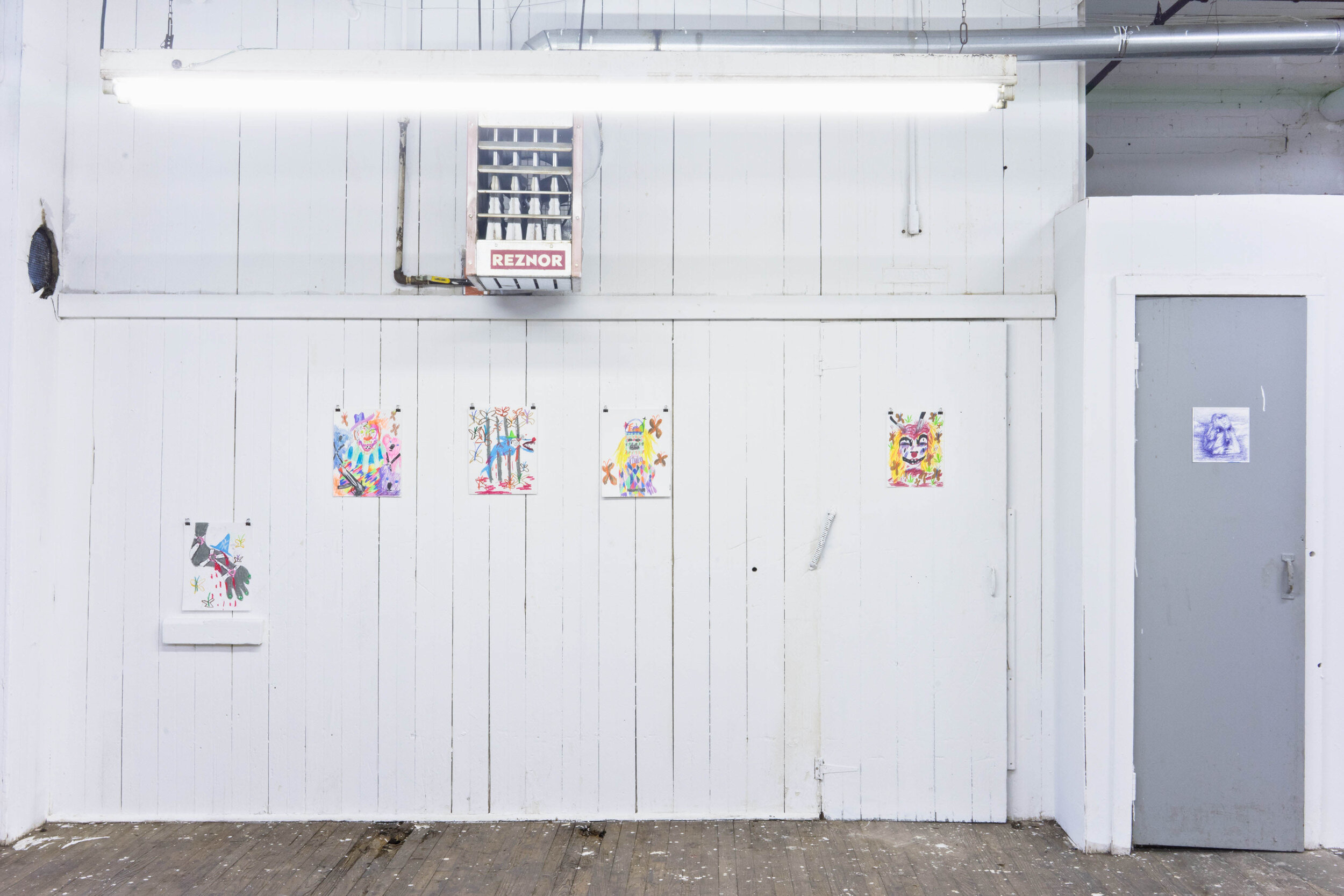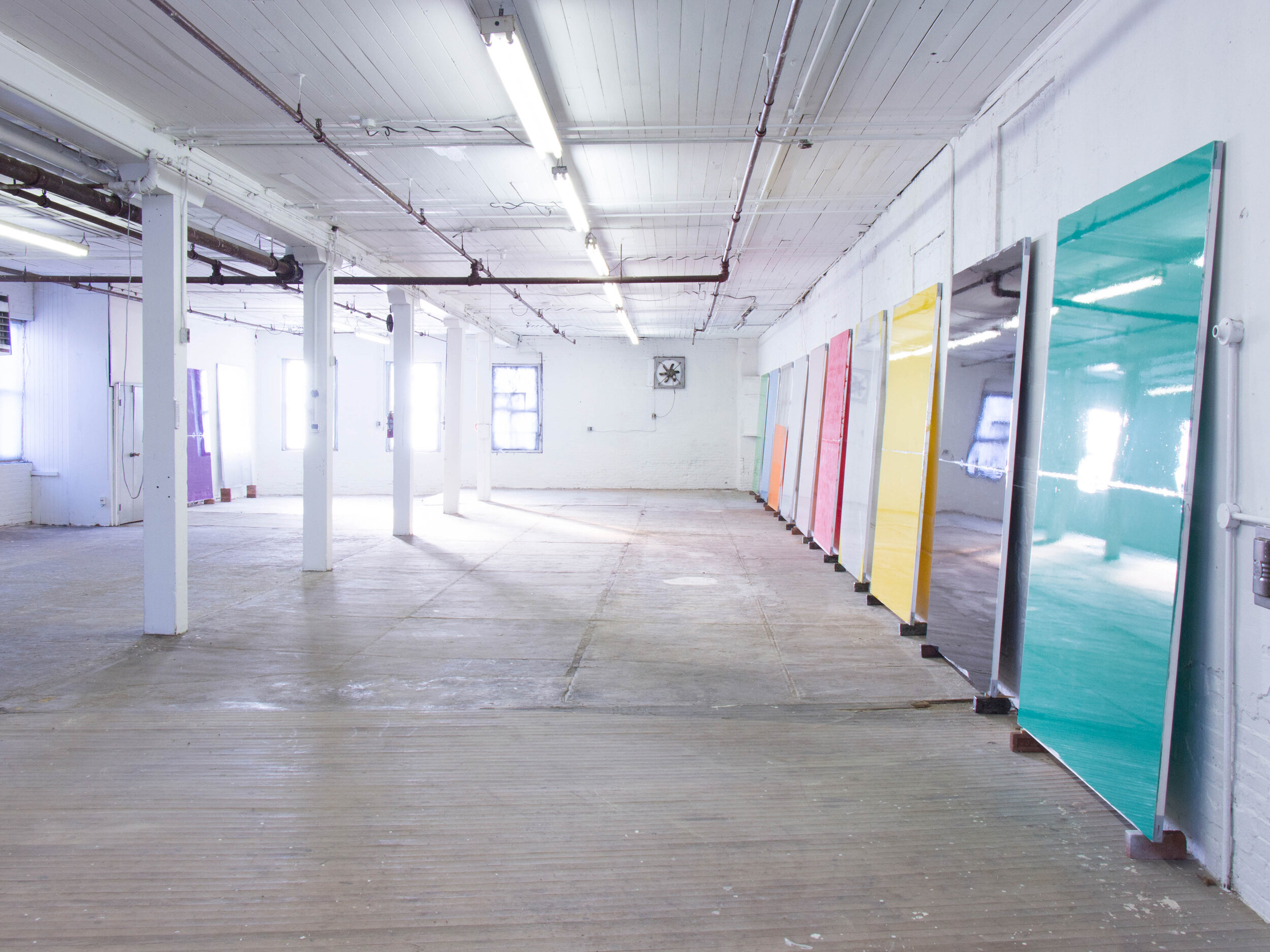Vicki
327 Liberty Street
Newburgh, NY, 12550
vicki.fun
@vickivickivickivickivicki
Some time ago, the city of Newburgh, New York was known as the Hudson Valley’s primary industrial hub. Today, much of it lies vacant. A factory on the corner of Liberty Street and Gidney Avenue, once the home of a ladies’ coat manufacturer called the Vicki Clothing Company, is sometimes occupied by an eponymous project by Samuel Boehm and Daniel Giordano. Vicki is a combination of Sam’s what-ifs and Daniel’s can-dos. Shows are sporadic and multiform. Vicki’s appearance matches her surroundings: tenderhearted, but a little rough around the edges. Some might call her pretty punk.
Lorna Bauer, Simon Belleau, Méghane Voghell, May West, installation view.
Interview with Vicki
with Founders Daniel Giordano and Samuel Boehm
Questions by Emily Burns
Hi Daniel and Samuel! Can you fill us in on the story of how Vicki came to be?
DG: The name comes from the Vicki Clothing Company, named after my Aunt Vicki. It was the name of the coat manufacturing business that my grandfather and then father owned and operated.
SB: We came up with the idea in grad school to host exhibitions in and around the factory building since there was so much space available to do so.
Vicki is located in your family’s factory in Newburgh, in upstate New York. Is the factory still functional? What was produced there?
DG: Vicki is located on a main artery of the City of Newburgh called Liberty Street. There is an electricity, a pulse here. There are block parties every night. It is weirdly urban and filthy, and abandoned.
SB: The Vicki Clothing Company, which produced ladie’s coats, is no longer functioning.
DG: Like a lot of businesses in the Hudson Valley, it couldn’t complete with off-shore manufacturing and closed down in the mid nineties.
What is Newburgh like? Are there many other galleries in the area?
DG: The City of Newburgh is raw, gritty, underground— bleak, yet beautiful. The architecture is crumbling but nevertheless lovely. There is trash everywhere. Loads of drugs and gang bangouts. I seriously consider it the Wild West where I can do whatever I damn please. This is how it always was for me. There are a few other projects in Newburgh. Lacey Fekishazy hosts an annual outdoor sculpture show called Glenlily Grounds. Kelly Schroer runs a project called Strongroom. In the greater region, there are all sorts of places. Across the river in Beacon is Mother Gallery, run by Paola Oxoa, and in Garrison, there is the Ice House, run by Jayne Drost Johnson.
SB: And of course there are the larger institutional sorts of places like Storm King and Dia:Beacon.
Are you from Newburgh originally?
DG: Yes, I grew up in Newburgh. I have lived between here and the City for about a decade now.
SB: I’m from West Virginia originally. Daniel and I met in Delaware. I’ve lived all over the Mid-Atlantic in recent years.
I know the towns in that area have been changing quite a bit in the last few years. Are more artists setting up studios in the area?
SB: While we were setting up one of the shows a few years ago we looked out the window and there was a couple riding expensive touring bikes down Gidney Avenue. We immediately said that it must have been a sign. Then we heard about developers buying up rowhouses and such. Artists are moving in nearby and some are showing up to Newburgh, but our part of town isn’t the most… comfortable. It hasn’t been as rapid as we first thought.
DG: We don’t feel there will be noticeable change for a long time coming and we don’t mind. We love it the way it is.
Can you tell us more about the space itself? From the photos the interior is beautiful! It looks like it has really tall ceiling and is beautifully restored and clean, but with a lot of personality coming from the bones of the building, like staircases, a funky floor, painted tin ceiling, and tongue-and-groove paneling along the top wall. So much subtle texture.
SB: We began by hosting large scale shows on the first floor of the factory.
DG: Which is roughly 4,000 square feet. That’s where the finishing details once happened, pockets and buttons and the like.
SB: There are a few nice trap doors in there.
DG: More recently, we’ve moved to the more reasonably-sized storefront next door. It was originally a gas station and mechanic’s office. Besides the addition of a little bit of white paint, both spaces maintain their original character.
Ted Gahl, Zen Paintings, installation view.
I am particularly drawn to gallery spaces that reflect the architecture of the space, or even resemble domestic spaces. How has the personality of the structure of the space itself contributed to the overall vibe or your goals?
DG: The spaces in the factory always seem to influence installs and the work that is included. The situation put on by the 181, our first show, directly interacted with the architecture of the space. Jim Lee made work onsite to match the scale of the factory floor. His sound sculpture was also site-conditioned.
SB: Lorna installed her glass sculptures according to the light at certain times of day, and Simon’s work gained a sort of narrative quality through the space’s architectural quirks.
DG: We want to give artists the opportunity to do whatever they please and are open to the possibilities of what they want to show.
What are your openings like?
DG: Our receptions are informal, casual, and charming.
SB: People often venture up from the City and from around the Hudson Valley. For Ted’s show, our neighbor Donald made tacos in the parking lot.
DG: We want there to be some local flavor.
By my count, you have had six exhibitions in the space so far. Have your goals or overall vision changed from the beginning?
DG: Our spirit is to do whatever we want when we want to do it. Moderation even in moderation.
Are you the primary curators? What types of work are you most interested in showing? What is something that ties the exhibitions together?
DG: Sam and I co-organize every show. We don’t consider ourselves curators, per se. In fact, Sam actively avoids that word. I guess we aren’t looking for another slash next to our names.
SB: Basically, we show work that we believe in and want to give a platform. We want the Vicki brand to be punky, funky, and cutting edge.
Group exhibition, Monster Mash, installation view.
In addition to running the space, you are also artists. Is your studio in the same building? Can you talk about how you wear both of these rather different hats?
DG: I make work on the third floor of the factory building. I refer to it as the Lion’s Den. I work in, on and around everything that was left behind from the family business— old Singer sewing machines, rolls of fabric, coats, iron hangers, and tons of Tony’s miscellaneous garbage. It all creeps into the work. I make larger scale works and do most of my deep-fry battering of objects in the three bay garage next to the space where we put on the last two shows. I love being able to work out of my family’s factory and feel fortunate to be able to do so. Growing up, all of the seamstresses and workers were my extended family. There are a lot of memories here.
SB: At the moment, I live and work three hours away, oddly enough. Shows happen when Daniel and I both have some time.
DG: We feel that a staggered program makes each show more of an event. It keeps people salivating for more and gives us the time to work on our own things in the interim.
SB: Luckily, meeting artists is part of being one. When we stumble across something we like, we try to get a show out of it.
DG: We install and shoot the shows at a rapid clip.
What is a typical day like for you?
DG: I wake up, drink tea, slather on sunscreen, make myself food to last me the entirety of the day, and finally head to the factory to crank out work. During all of that I am usually yapping on the phone because I am a social monster and I revel in it.
SB: I’ve always worked a 9 to 5. I try to squeeze in studio time in the early morning. There’s lots of coffee in there somewhere. Nearly the entirety of my evening is spent scrolling through art, objects, and design online. I’m mostly interested in material things.
In a previous interview with The Rib, Samuel mentioned that you are working against a lot running the space in this location. What keeps you going?
DG: Dedication and topophilia keep it all going strong.
SB: It feels important to us.
What has stood out as the biggest joy in running the space so far? The biggest challenge?
DG: We love that we’re building a tribe.
SB: Sometimes it’s a challenge lining up our schedules. Despite our whinging, the neighborhood shenanigans are really all positives.
DG: They add flavor to the mix.
Can you tell us a bit about Ted Gahl’s current solo show, Zen Paintings, that’s up now? Were the paintings made specifically for this space? It’s a gorgeous show.
SB: On behalf of Vicki and Ted, thank you. The work is all new, but not made for the space. Actually, this particular show happened because Ted joked that the Zen paintings were going to end up in a closet somewhere. I replied, “no, Ted, they’re headed to Vicki!”
What’s up next for Vicki?
DG: Vicki is off to Florida for the winter like a good New Yorker. She is visiting her son and getting her winter tan.
SB: Come spring, she will have more cheesecake for you.
Thanks so much for talking with us!
Thank YOU!
To find out more about Vicki, check out the website.






